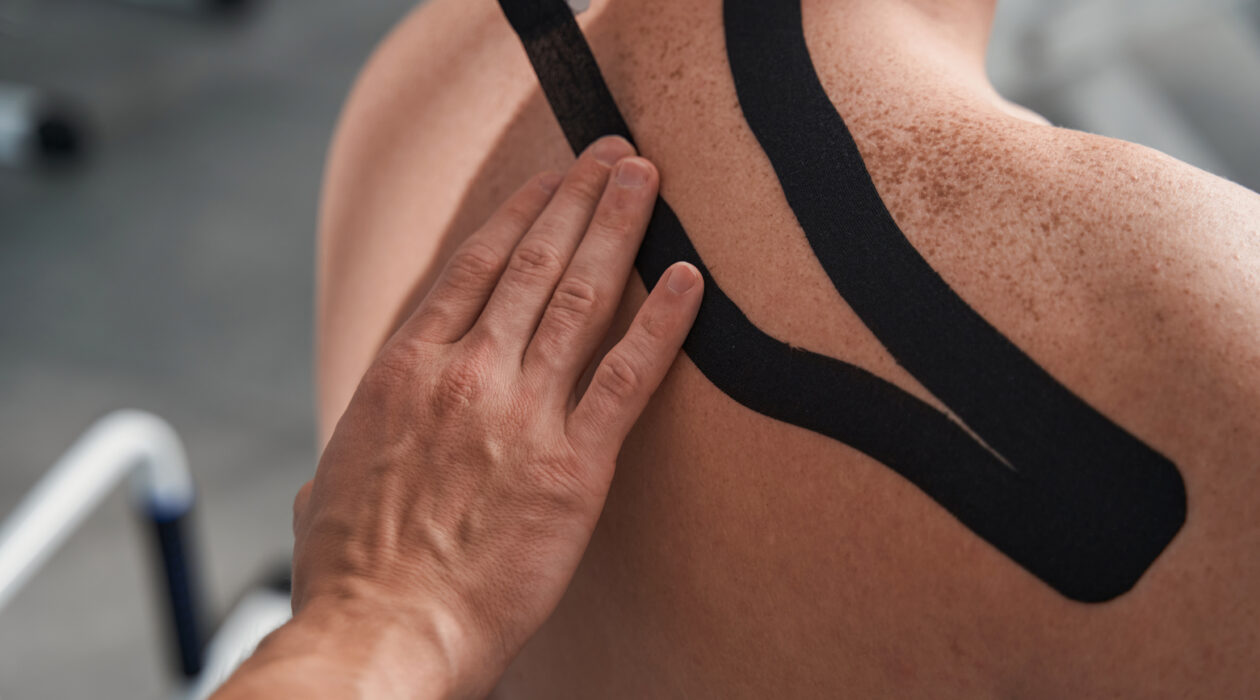KT Tape, short for Kinesiology Therapeutic Tape, has emerged as a revolutionary tool in sports and injury management. Initially developed in the 1970s by Dr. Kenzo Kase, a Japanese chiropractor, KT Tape has evolved into a widely recognized and utilized product in sports medicine and physical therapy. Its unique design, a blend of cotton and nylon, mimics the elasticity of human skin, allowing for the full range of motion while providing targeted support to muscles, tendons, and ligaments. This innovative tape is not just for elite athletes; it benefits anyone seeking relief from muscular pain, swelling, or injuries.
Its versatility extends to various applications, from enhancing athletic performance to accelerating injury recovery. The tape’s hypoallergenic adhesive ensures it can be worn for several days, enduring through intense workouts, showers, and daily activities. As a non-invasive and drug-free solution, KT Tape has become a staple in injury prevention and recovery strategies, offering support and relief simply yet effectively.
Understanding Kinesiology Therapeutic Tap
What is KT Tape?
KT Tape, or Kinesiology Tape, is a therapeutic tape applied strategically to the body to provide support, lessen pain, reduce swelling, and improve performance. It’s made from a blend of cotton and nylon, designed to mimic the skin’s elasticity, allowing a full range of motion. The tape’s adhesive is water-resistant and robust, enabling it to stay on for days. KT Tape is used in various ways, including facilitating muscle function, stabilizing joints, reducing pain and swelling, and enhancing athletic performance.
History and Development of KT Tape

KT Tape was developed in the 1970s by Dr. Kenzo Kase, a Japanese chiropractor. Unlike traditional athletic tapes, Dr. Kase sought a tape that provided support without limiting movement. This led to the creation of Kinesio Tape or Kinesio Tex Tape, the original kinesiology tape. The tape’s unique design and elasticity were intended to mimic the skin’s properties, offering therapeutic benefits while allowing athletes and patients to maintain a full range of motion. Over time, KT Tape has evolved and become widely used in sports medicine and physical therapy, with numerous brands now available.
Types of KT Tape
There are various types of KT Tape, each serving different functions for specific conditions. The main types include:
- Original Cotton: Comfortable and water-resistant, suitable for light activity and general wear.
- Gentle: Designed for sensitive skin, with a soft adhesive.
- Pro: Made from synthetic material, it is ideal for strenuous exercise and longer wear.
- Extreme: Features the strongest bond for intense activities and water resistance.
- Pro Wide: Double-wide strips for larger muscle groups like the lower back.
- Oxygen: Embedded with cellular infrared technology to improve cellular oxygenation.
Benefits of Using KT Tape
KT Tape offers several benefits:
- Pain Relief: Reduces pain by lifting the skin and decreasing pressure on underlying tissues.
- Swelling Reduction: Enhances lymphatic drainage and reduces inflammation.
- Support and Stability: Provides support to muscles and joints without restricting movement.
- Enhanced Performance: Can improve athletic performance by supporting fatigued muscles.
- Injury Prevention: Helps in preventing overuse and compensatory injuries.
- Improved Circulation: Assists in increasing blood flow to the taped area.
- Versatility: Suitable for various conditions, from sports injuries to chronic pain management.
- Extended Wear: Can be worn for several days, providing continuous therapeutic benefits.
Practical Applications of KT Tape
Application Techniques for Common Injuries
KT Tape is widely used for common sports injuries like sprains and strains. The tape is applied over and around the injured joint for sprains, supporting and limiting excessive movement. For muscle strains, it’s used along the length of the affected muscle, aiding in muscle function and reducing pain. The tape’s elasticity allows for a range of motion, helping recovery without immobilizing the area.
KT Tape in Various Sports

KT Tape is used in various sports disciplines for its versatility and effectiveness. Runners use it for shin splints and knee support, while swimmers apply it for shoulder stability. In basketball and volleyball, athletes use it for ankle sprains and jumper’s knees. Cyclists and weightlifters benefit from its use on the lower back and shoulders, providing support and pain relief during intense physical exertion.
Daily Use and Injury Prevention

For daily fitness routines, KT Tape is an excellent tool for injury prevention. Regular users apply it to areas prone to stress, like knees and ankles, during high-impact activities like running or jumping. It’s also used for posture correction during workouts, reducing the risk of strain-related injuries. Its application in daily routines enhances muscle activation and joint stability, making it a preventive measure against potential injuries.
Proper Application and Safety
Step-by-Step Guide to Applying KT Tape
- Clean the Skin: Ensure the application area is clean and dry.
- Measure and Cut: Measure the tape length needed and cut, rounding the corners to prevent peeling.
- Anchor the Tape: Apply the first end of the tape without stretching to anchor it.
- Apply with Stretch: Stretch the tape as needed (usually 50-75% of its maximum stretch) and apply along the muscle or joint.
- Rub to Activate Adhesive: Rub the tape to activate the heat-sensitive adhesive for better adhesion.
Do’s and Don’ts
- Do the skin is clean and dry before application.
- Do apply the tape at least an hour before physical activity.
- Don’t apply the tape on irritated or broken skin.
- Do use the appropriate stretch level for different applications.
- Don’t stretch the ends of the tape during application.
- Do consult a professional for application techniques for specific injuries.
- Don’t ignore pain or discomfort while using the tape.
- Do remove the tape gently, preferably after applying oil or lotion, to ease removal.
Product Selection :
Uncut Roll :
KT Tape, Original Cotton

It offers non-restrictive, pain-relieving support for muscles and joints, enhancing comfort and motion. Its 16-foot, uncut roll allows for customizable lengths with DIY rounded corners. The tape’s durable, cotton-elastic composition with strong adhesive ensures 1-3 days of wear, even in harsh conditions. Ideal for various pains, it’s easily self-applied and adaptable for different body parts. Hypoallergenic and free from rubber and latex, it’s designed for skin safety.
Precut Strips :
KT Tape, Pro Extreme Synthetic Kinesiology

This USA-made KT Tape offers extreme support with 100% synthetic performance fibers that are fast-drying, water-resistant, and provide superior strength. Its stronger elastic core ensures prolonged muscle, joint, and tendon support compared to cotton. The tape comes in convenient 10-inch precut strips, with 20 in a pack. Exceptionally durable, it withstands showers, pools, and beach activities, staying in place for 4-7 days with rounded corners to prevent snagging on clothes.
KT Tape, Original Cotton

It comes in a pack of 20 precut 10-inch strips for easy application. Made of classic cotton with an elastic core, the tape’s strong adhesive ensures durability for 1-3 days, even in extreme weather. Its versatile use includes treatment for back, knee, shoulder pain, and more, with the KT App ensuring correct application.
FAQ
What does KT Tape do?
KT Tape provides support and pain relief for muscles, tendons, and ligaments. It increases stability, decreases discomfort, and lifts the skin to enhance local blood flow and reduce post-workout muscle soreness. The tape’s unique design allows flexible support without restricting movement, making it ideal for everyday activities and professional athletes. It’s particularly effective in managing pain, soreness, or injuries in various body parts.
How long do you leave KT tape on?
The duration for which KT Tape can be worn varies depending on the type. Original Cotton KT Tape is suitable for 1-3 days of wear, ideal for light activity and everyday use. KT Tape Pro, designed for more strenuous activities, remains effective for 4-7 days. KT Tape Pro Extreme, with the strongest adhesive, lasts 4-7 days for the most intense workouts, offering robust support and durability.
Does KT Tape go directly on the skin?
Yes, KT Tape is applied directly to the skin. It’s designed to adhere securely while accommodating movement and activity. For sensitive skin, KT Tape Gentle offers a milder adhesive. Before application, the skin should be clean and dry, and shaving the area may be necessary for those with thicker body hair. The tape’s hypoallergenic and latex-free nature makes it suitable for direct skin application, ensuring comfort and effectiveness.
What is the science behind kinesiology tape?
The science behind kinesiology tape, like KT Tape, involves affecting proprioception through skin mechanoreceptors. This can improve active movement control and alter sensory feedback perceived as pain. KT Tape is also observed to enhance the body’s natural uptake of interstitial fluid and debris from injuries, augmenting the lymphatic system’s mechanical action. This dual action of proprioceptive influence and lymphatic support underpins the therapeutic benefits of kinesiology tape in pain relief and physical support.
In the End :
KT Tape has established itself as an indispensable sports and injury management tool. Its ability to provide support, alleviate pain, and facilitate faster recovery makes it a valuable asset for athletes, fitness enthusiasts, and individuals with musculoskeletal issues. The tape’s innovative design allows for natural movement while offering targeted therapeutic benefits, bridging the gap between full mobility and adequate support. Its widespread adoption in various sports and therapeutic settings underscores its effectiveness and versatility. Ultimately, KT Tape represents a significant advancement in non-invasive treatment methods, offering a practical solution for enhancing athletic performance and aiding in the healing process of injuries.














